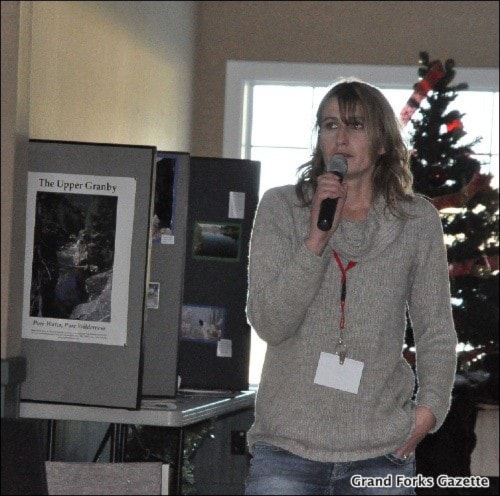In its seventh annual review on Dec. 5, the Christina Lake Stewardship Society (CLSS) discussed a year of projects from milfoil removal to riparian projects, and future goals.
Projects from this year include the North Bay Buoy Project, the Zebra and Quagga Mussel Monitoring Project, the Kettle River Watershed Management plan, and continuing monitoring projects.
Water Quality
Environmental Impact Biologist Mike Sokal, from the Environmental Protection Division of the Ministry of Environment, discussed the water quality of the lake.
He noted key parameters include physical attributes (clarity, temperature), nutrients (nitrogen, phosphorus content), and ions (silica).
When examining Christina Lake, Sokal takes samples from two parts of the lake: the northern deep site at 51 metres (0.051 kilometres) since 1991 and the south shallow site at 26 metres (0.026 kilometres) since 1972.
Christina Lake is considered an oligotrophic lake because it is low in nutrients such as phosphorus and nitrogen; however, the increase in phosphorus is a concern.
The increase of phosphorus means there will also be a corresponding increase in algae. Sokal noted efforts need to be made to reduce non-point sources, such as other organic chemicals and pharmaceuticals and personal care products entering the lake.
More information will be available on the Ministry of Environment’s website in the spring.
Zebra and quagga mussels
Boaters travelling from the United States are a concern to environmentalists and biologists because they may be transporting zebra and quagga mussels, two highly invasive species.
Barb Stewart, co-ordinator for the Boundary Invasive Species Society, noted mussels are not currently a problem at the lake or nearby rivers and streams but there should be a constant vigilance.
“Should mussels somehow find their way here, they would have a huge impact on our freshwater environment,” Stewart explained.
Changes would occur to the algae, ecosystem size, the clogging of water intakes, decrease recreational use and because it is persistent, the ecosystem does not recover over time, Stewart added.
In the U.S., there are boat inspection stations where travelling boats are cleaned and inspected for hidden mussels.
There are currently no inspection stations in British Columbia and Christina Lake does not have its own boat washing station.
“It’s a challenge to install one because the water has to be really hot,” she said. “With a station there will also have to be a supervisor at hand because people may burn themselves.”
Stewart did point out along with mussels there are other invasive species, such as the flowering rush, that are also a concern.
Milfoil and weevils
Another invasive species, the Eurasian water milfoil, saw a big chunk removed from the lake after the RDKB doubled its diving crew.
Andy Gilmore, the scuba diver crew supervisor, noted the budget was increased to $300,000 and they were able to double the dive crew to seven divers.
“This year we worked seven days a week for a total of 24 weeks,” Gilmore explained. “This is the longest stretch of work that’s been done at the lake; it started on May 7 and completed on Oct. 31.”
In 2011, the team only had three divers. Gilmore added the teams concentrated on the most severe areas and areas that were previously abandoned in the south end of the lake.
“Our goal was to retake most of the southern bay,” said Gilmore. “We were also able to retake the provincial campground and Crown (land) that had been previously abandoned. In the southern bay alone, 250,000 plants were removed, which was never done in the last three years, so it was a huge increase in productivity. We were removing four to five truck loads every Thursday out of the southern bay alone.”
From there, the plants would be dropped off at Durand’s Nursery to be used as organic fertilizer.
Another change in this year’s program was the addition of a GPS tracker so residents could see where the divers were working during the day. The tracking system was available on the RDKB website.
CLSS also received news that the weevils found in the lake are naturally produced. There is no set date on when the possibility of a weevil-rearing project may begin, but CLSS members were optimistic by the result.
BC Timber Sales
Logging up by Stewart Creek Road in Christina Lake has already begun and is likely to be complete by the fall of 2013.
Dawn Guido, practices forester with BC Timber Sales in Grand Forks, explained there were 12 logging blocks sold this past summer in two individual sales packages for logs to two local contractors.
Guido noted one has already begun to start harvesting and is likely to be finished within the next few months, while the other contractor aims to start after spring and will be complete in the fall of 2013. Between two and 40 hectares, the 12 blocks are located more than a kilometre away from Christina Lake and include four watersheds: Spooner Creek, Gill Creek, Bart Creek and Stewart Creek.
“As far as our future plans are concerned, we don’t have any plans currently for the Christina Lake operating area,” said Guido. “Our plans go up to two to three years and there are no timber sales in those plans for two to three years. However, plans are flexible and they change so there is a possibility we may be looking at this area.”
Planting of mixed tree species, from spruce to pine, begins within a year of harvesting. For more information on CLSS, visit lakesteward.ca.
